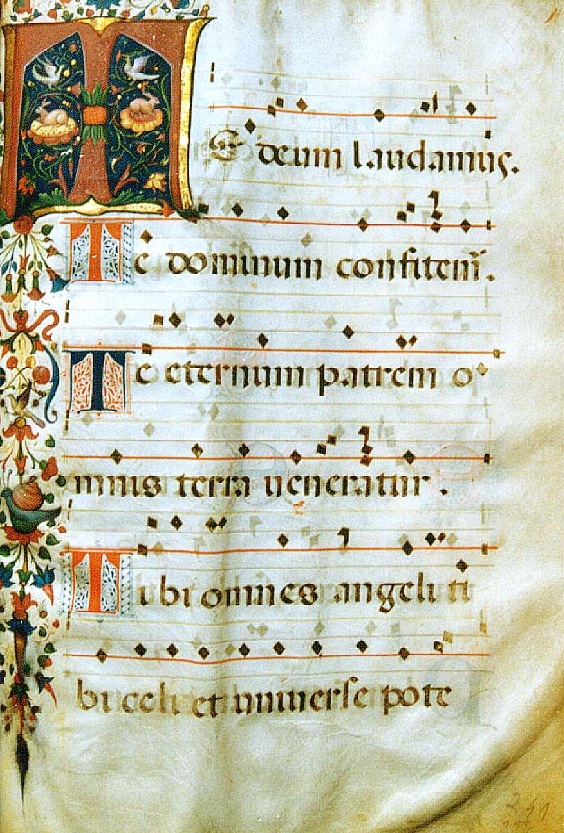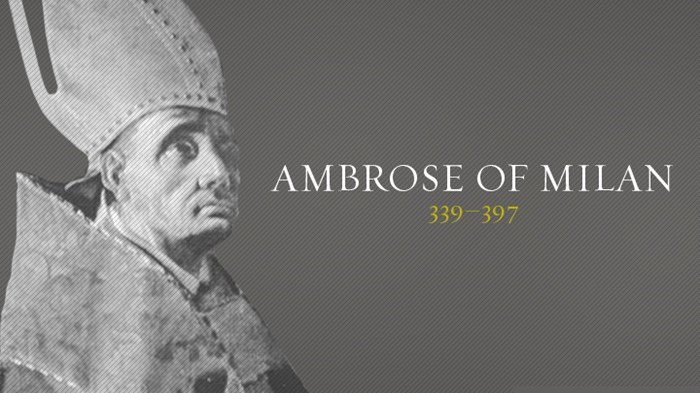
This famous church confession in song was composed A.D. 387 by Ambrose, Bishop of Milan, probably both words and music.
Te Deum laudamus, Te Dominum confitemur
Te aeternum Patrem omnis terra veneratur
Tibi omnes angeli, tibi coeli et universae potestates,
Tibi cherubim et seraphim inaccessibili voce proclamant
Sanctus, sanctus Dominus Deus Sabaoth.
In the whole hymn there are thirty lines. The saying that the early Roman hymns were echoes of Christian Greece, as the Greek hymns were echoes of Jerusalem, is probably true, but they were only echoes. In A.D. 252, St. Cyprian, writing his consolatory epistle* during the plague in Carthage, when hundreds were dying every day, says, “Ah, perfect and perpetual bliss! [in heaven.] There is the glorious company of the apostles; there is the fellowship of the prophets rejoicing; there is the innumerable multitude of martyrs crowned.” Which would suggest that lines or fragments of what afterwards crystalized into the formula of the “Te Deum” were already familiar in the Christian church. But it is generally believed that the tongue of Ambrose gave the anthem its final form.
Ambrose was born in Gaul about the middle of the fourth century and raised to his bishopric in A.D. 374. Very early he saw and appreciated the popular effect of musical sounds, and what an evangelical instrument a chorus of chanting voices could be in preaching the Christian faith; and he introduced the responsive singing of psalms and sacred cantos in the worship of the church. “A grand thing is that singing, and nothing can stand before it,” he said, when the critics of his time complained that his innovation was sensational. That such a charge could be made against the Ambrosian mode of music, with its slow movement and unmetrical lines, seems strange to us, but it was new and conservatism is the same in all ages.
The great bishop carried all before him. His school of song worship prevailed in Christian Europe more than two hundred years. Most of his hymns are lost, (the Benedictine writers credit him with twelve), but, judging by their effect on the powerful mind of Augustine, their influence among the common people must have been profound, and far more lasting than the author's life. “Their voices sank into mine ears, and their truths distilled into my heart,” wrote Augustine, long afterwards, of these hymns; “tears ran down, and I rejoiced in them.”
Poetic tradition has dramatized the story of the birth of the “Te Deum,” dating it on an Easter Sunday, and dividing the honor of its composition between Ambrose and his most eminent convert. It was the day when the bishop baptized Augustine, in the presence of a vast throng that crowded the Basilica of Milan. As if foreseeing with a prophet's eye that his brilliant candidate would become one of the ruling stars of Christendom, Ambrose lifted his hands to heaven and chanted in a holy rapture, -
We praise Thee, O God! We acknowledge Thee to be the Lord;
All the Earth doth worship Thee, the Father Everlasting.
He paused, and from the lips of the baptized disciple came the response,
To Thee all the angels cry aloud: the heavens and all the powers therein.
To Thee cherubim and seraphim continually do cry,
“Holy, holy, holy Lord God of Sabaoth;
Heaven and Earth are full of the majesty of Thy glory!”
and so, stave by stave, in alternating strains, sprang that day from the inspired lips of Ambrose and Augustine the “Te Deum Laudamus,” which has ever since been the standard anthem of Christian praise.
Whatever the foundation of the story, we may at least suppose the first public singing of the great chant to have been associated with that eventful baptism.
The various anthems, sentences and motets in all Christian languages bearing the titles “Trisagion” or “Tersanctus,” and “Te Deum” are taken from portions of this royal hymn. The sublime and beautiful “Holy, Holy, Holy” of Bishop Heber was suggested by it.
THE TUNE
No echo remains, so far as is known, of the responsive chant actually sung by Ambrose, but one of the best modern choral renderings of the “Te Deum” is the one by Henry Smart in his Morning and Evening Service. In an ordinary church hymnal it occupies seven pages. The staff-directions with the music indicate the part or cue of the antiphonal singers by the words Decani (Dec.) and Cantor (Can.), meaning first the division of the choir on the Dean's side, and second the division on the Cantor's or Precentor's side.
Henry T. Smart (1813–1879)
Henry Smart was one of the five great English composers that followed our American Mason. He was born in London, Oct. 25, 1812, and chose music for a profession in preference to an offered commission in the East Indian army. His talent as a composer, especially of sacred music, was marvellous, and, though he became blind, his loss of sight was no more hindrance to his genius than loss of hearing to Beethoven.
No composer of his time equalled Henry Smart as a writer of music for female voices. His cantatas have been greatly admired, and his hymn tunes are unsurpassed for their purity and sweetness, while his anthems, his oratorio of “Jacob,” and indeed all that he wrote, show the hand and the inventive gift of a great musical artist.
He died July 10, 1879, universally mourned for his inspired work, and his amiable character.
Hezekiah Butterworth
1839–1905
Theron Brown
1832–1914

''When we are speaking about truth and life and redemption, we are speaking about Christ''
